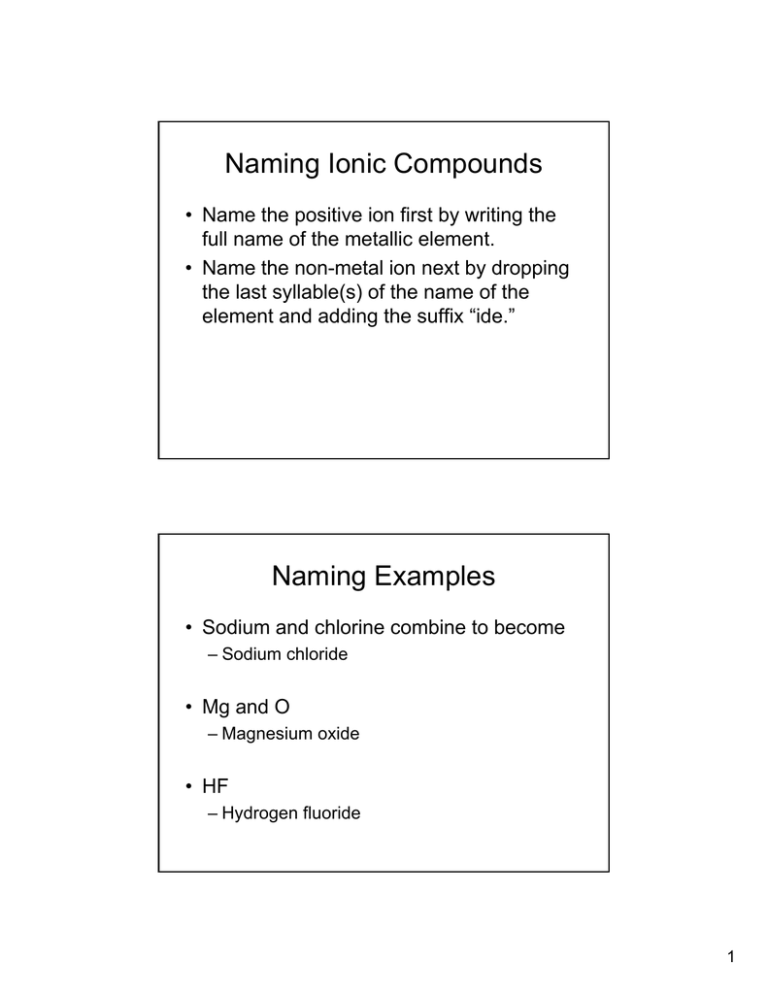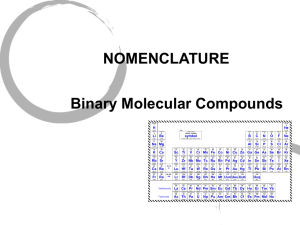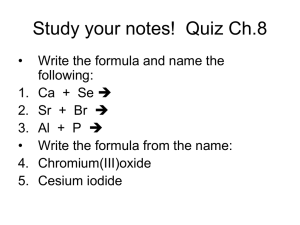Naming Ionic Compounds
advertisement

Naming Ionic Compounds • Name the positive ion first by writing the f ll name off the full th metallic t lli element. l t • Name the non-metal ion next by dropping the last syllable(s) of the name of the element and adding the suffix “ide.” Naming Examples • Sodium and chlorine combine to become – Sodium chloride • Mg and O – Magnesium oxide • HF – Hydrogen fluoride 1 The Stock System • Used for elements that can have more th one cation. than ti – Fe2+ - Iron(II); Fe3+ - Iron(III) – Cu+ - Copper(I); Cu2+ - Copper(II) Polyatomic Ions • There are some special groups of atoms off more than th one element. l t – OH- (hydroxide) – NH4+ (ammonium) – NO3- (nitrate) – SO4- (sulfate) 2 Writing Chemical Formulas for Ionic Compounds • Write the chemical ssymbol mbol for both ions (including the charge) • “Cross-over” the charge numbers ignoring the signs • Simplify if possible Aluminum Oxide Al 3+ O 2- • Write the chemical symbol for both ions (including the charge) 3 2Al 3+ O 2 3 • “Cross-over” the charge numbers ignoring the signs Al 2 O 3 • Simplify if possible 4 Iron(II) Oxide Fe2+ O 2- • Write the chemical symbol for both ions (including the charge) 2Fe 2+ O 2 2 • “Cross-over” the charge numbers ignoring the signs 5 Fe2 O 2 Fe O • Simplify if possible Examples • Magnesium Fluoride – MgF2 • Sodium Oxide – Na2O • Copper(II) Oxide – CuO C O 6 Naming Binary Molecular Compounds • The first non-metal name is written in full. • The second non-metal element is named with the suffix “ide” ending. • Assign a prefix to each element expressing the number of atoms present in the molecule. molecule Prefixes • Mono=1 (only used with the second element) l t) • Di = 2 • Tri = 3 • Tetra = 4 • Penta = 5 • Hexa = 6 7 Examples • CO2 – Carbon dioxide • N 2O 5 – Dinitrogen pentoxide Writing Chemical Formulas for Binary Molecular Compounds • Write the chemical ssymbol mbol for both elements • Write the number indicated by the prefix 8 Tricarbon tetrahydride C H • Write the chemical symbol for both elements C3 H4 • Write the number indicated by the prefix 9 Examples • Nitrogen monoxide – NO • Sulfur trioxide – SO3 • Carbon tetrachloride – CCl4 • Dicarbon Hexahydride – C2H6 10


